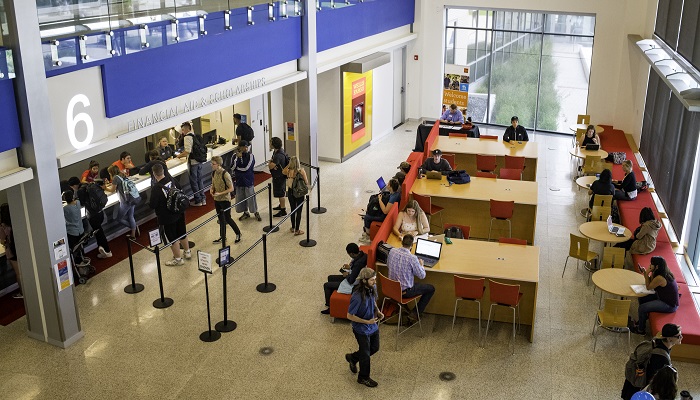

Enrollment update
Sean Petranovich, Ph.D., director of Data and Analytics, began Friday’s meeting of the Budget Recommendation Committee by sharing the latest enrollment news and trends.
One week into the summer semester, full-time-equivalent undergraduate enrollment was 14.33% lower than summer 2021; head count was down 9.34%. Graduate-student FTE enrollment was down 4.64%, with head count down 6.6%.
As of Tuesday, approximately 10 weeks out from the beginning of the fall semester, undergraduate FTE enrollment was down 7.2% compared with the same time before fall 2021, and overall head count was down 5.8%. Graduate-student FTE enrollment was down 5.7%, with head count down 4.1%.
Petranovich also referenced February’s enrollment forecast, which estimated a fall 2022 head count down 6% from fall 2021, meaning the University will likely improve on this earlier estimate. Current retention rates are a few percentage points ahead of fall 2021 numbers; however, FTEs remain lower. He added that Roadrunners across all student types are, on average, enrolling in lighter credit-hour loads. At this point last year, 59.5% of students were enrolled full-time (at least 12 credits) for fall, but that number has dipped to 57% for 2022.
Petranovich noted a loss of returning students for the summer semester but that registered first-time undergraduate students are up. First-time students (including first-year and transfer) enrollment is also 2.8 percentage points higher for fall 2022. The University is also 3 percentage points higher compared with this time last year in preliminary retention rate; however, the University has a smaller overall retention base for fall 2022 than in previous semesters.
Predictive modeling has helped the University reach students who were not likely to retain, and approximately 40% of those students identified have registered for fall 2022. One hundred students of the 600 eligible have also taken advantage of the $1,000 dean’s-grant initiative.
An additional enrollment challenge is the trend of students registering later in the year. “It’s highly likely that we will see a surge closer to the start of the semester,” Petranovich said.
Fiscal 2023 budget projections
George Middlemist, Ph.D., associate vice president for Administration and Finance, began by breaking down how the University will use the extra $10.2 million in state-allocated funding. He noted that the anticipated decrease in enrollment will total a loss of roughly $5.5 million in tuition revenue even with the 2% tuition-rate increase. This loss is coupled with the increase in mandatory expenses, such as health-insurance premiums, classified-staff compensation increases and PERA contributions. The anticipated enrollment decline and increased expenses will leave the University with approximately $800,000 of the original $10.2 million. Were the University to achieve the same enrollment level as fall 2021, tuition revenue would add approximately $8.2 million to the budget.
Several strategies to increase enrollment include the addition of two new recruiter positions, the Roadrunner Promise scholarship program, the Indigenous Student Scholarship, Pathways to Possible and investments in experiential learning and high-impact strategies.
Middlemist’s team has also been working closely with senior leaders to review actual branch spending vs. requests to identify potential savings and reallocations to staffing and resources.
Compensation Subcommittee recommendation
The Compensation Subcommittee is recommending that administrators, professional staff and faculty (Categories I, II and affiliate) all receive a 3% across-the-board increase to mirror the state-mandated 3% cost-of-living increase for classified staff. The committee also recommends that the University continue to observe College and University Professional Association averages. Together, these recommended compensation strategies would total approximately $4.2 million.
The deans expressed a desire to further monitor enrollment prior to voting, while the Student Advocacy Council voiced concern over current student-employee wages. Members also discussed a reduced compensation increase with an increased investment in enrollment and retention strategies. The BRC will return to this conversation with more enrollment data and compensation scenarios at the next meeting.
Stuff that works
Middlemist outlined several programs that have proved successful in attracting and retaining students and that could be expanded to increase revenue, beginning with Pathways to Possible. The program is modeled on the high-impact TRIO Student Support Services program, which attracts about 300 new students annually. Pathways to Possible is expected to cover its costs in the first year and have a return on investment of 33% by Year 5.
The University is also considering growing the concurrent-enrollment program among high school students, which could generate up to 3,600 more credit hours for an estimated $1 million in additional tuition revenue.
Finally, investing approximately $1 million to expand internship programs is estimated to net $2 million in retained tuition revenues.
More details and data on these proposals will be available at the next BRC meeting.
New budget-process development
Matt Ceppi, executive director of Association of College and University Educators Consulting, presented on his work to support the University in developing a more holistic and sustainable budget process. Ceppi discussed elements of various budgeting approaches that could be valuable to MSU Denver’s process as well as his efforts to help MSU Denver make the best and most strategic use of resources by the next budget cycle.
Ceppi will work to identify and include a broader stakeholder community as well as areas of opportunity within the current budget process. He will also consider improved timelines, reexamining primary revenue drivers and alignment with key priorities. Future work will include:
- Examining and comparing successes and best practices from other universities with MSU Denver (peer and aspirational).
- Developing a more consistent approach to program assessment and metrics-gathering.
- Filling open positions strategically.
- Providing equitably budgeted and allocated assigned time for faculty members.
Ceppi is also seeking feedback on guiding principles to ensure collaboration, transparency, visibility and alignment with the Strategic Plan.
The group’s July meeting will cover FY23 one-time budget requests. Roadrunners can expect an update on Higher Education Emergency Relief Fund funding impacts in early fall.

